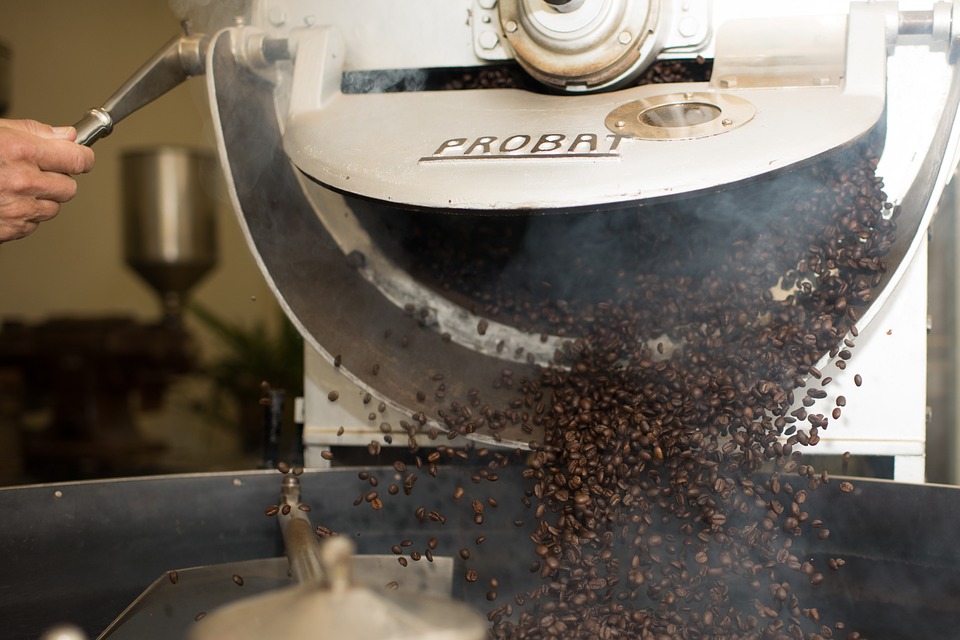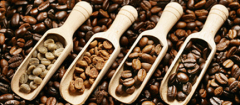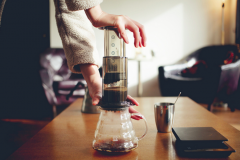How to control the three processes of baking: drying, high temperature decomposition and cooling

For professional baristas, please follow the coffee workshop (Wechat official account cafe_style)
Newly imported coffee beans are usually about 12% moisture, and when coffee beans are roasted at high temperatures ranging from 500 to 800 degrees Fahrenheit, the water evaporates when they heat up. Most of the moisture is released in the first few minutes of the baking process, although the baking time in the United States is usually about 15 minutes, which can be 5 minutes or as long as an hour. After 8 minutes, the temperature of the beans will rise to 300 degrees Fahrenheit and the beans will lose green, turn yellow and begin to turn brown. Between 260 and 370 degrees Fahrenheit, in 11 to 12 minutes, more water will slowly dissipate, coffee beans reach 390 degrees Fahrenheit, coffee becomes light brown. At 14 minutes, the temperature of the beans reaches 410 degrees Fahrenheit and the color becomes moderately brown. At 16 minutes, the temperature of the beans reached 440 degrees Fahrenheit and the color turned dark brown, almost equivalent to French baking. If you bake for another minute, the temperature will exceed 450 degrees Fahrenheit and turn into Italian and dark brown beans at 465 degrees Fahrenheit and 20% weightlessness.
The actual time control, the change of temperature and color will be based on the method of fried beans, cycle, the type of beans, the original moisture content, the speed of heating. And so on, rather than a universal description of the whole process. In all cases of baking, what really matters is that a large amount of heat is released from coffee beans at 400 degrees Fahrenheit, which is called high temperature decomposition or chemical decomposition of caramel. Sivetz invented the method of temperature and time measurement at the end of 1974. in June 1975, the A.S.I.C conference in Hamburg demonstrated that heat release is measurable and directly related to the baking quality of raw beans, that is, beans grown at the highest latitudes and the most fragrant beans release the most heat, the beans at lower latitudes are gently washed, releasing less heat, and the beans at the lowest latitudes are not released.
High temperature decomposition produces acetaldehyde and other attractive coffee aromas, which appear and maintain for a short time. High temperature decomposition determines how long the coffee taste lasts. That is, how deep we are allowed to roast coffee, some of the chemicals volatilized by coffee under high temperature decomposition are carbon dioxide, acetaldehyde, ketone, ether, acetic acid, methanol, vegetable oil, water vapor, glycerin. The particularly bad smell after baking is sour, and spicy and choking. The coffee roasting process usually takes 7 minutes in a continuous roaster and 12 to 15 minutes in a four-bag roaster. When the baking time is more than half an hour, the coffee beans will have a light baking flavor rather than a strong aroma. The baking process is usually accompanied by a crisp explosion and lampblack formed mostly by blue water vapor. As soon as you get the ideal coffee color, the coffee beans must be poured out of the extremely hot fire immediately, and quickly and correctly use the surrounding air and spray to cool. When you cool the coffee beans, most of the water will evaporate, and even if you spray a small amount of water mist, almost no water will be absorbed by the coffee beans. Cooled beans will stop the decomposition of high temperature. If you maintain the high temperature of the beans, the aroma will be much lower.
Important Notice :
前街咖啡 FrontStreet Coffee has moved to new addredd:
FrontStreet Coffee Address: 315,Donghua East Road,GuangZhou
Tel:020 38364473
- Prev

Factors affecting the depth of baking: color and weight loss
Communication of professional baristas Please pay attention to the coffee workshop (Wechat official account cafe_style) lightly fried beans contain more acid, so it is suitable for areas where alkaline water is used. Lower-grade coffee beans have poor taste characteristics, which can be easily revealed by shallow stir-frying. So usually we use deep stir-fry to drive away the bad volatiles in the beans. The mixture has been baked.
- Next

Five essentials for making delicious coffee
Professional baristas please pay attention to the coffee workshop (Wechat official account cafe_style) grinding roasted coffee beans has a lot to do with the grinding results. Coffee beans can not be ground immediately after baking, because they are not hard enough. If they are ground immediately, they will be broken, flattened and damaged. Coffee beans can only be ground when they cool and harden. There is a percentage of coffee beans themselves.
Related
- Beginners will see the "Coffee pull flower" guide!
- What is the difference between ice blog purified milk and ordinary milk coffee?
- Why is the Philippines the largest producer of crops in Liberia?
- For coffee extraction, should the fine powder be retained?
- How does extracted espresso fill pressed powder? How much strength does it take to press the powder?
- How to make jasmine cold extract coffee? Is the jasmine + latte good?
- Will this little toy really make the coffee taste better? How does Lily Drip affect coffee extraction?
- Will the action of slapping the filter cup also affect coffee extraction?
- What's the difference between powder-to-water ratio and powder-to-liquid ratio?
- What is the Ethiopian local species? What does it have to do with Heirloom native species?

